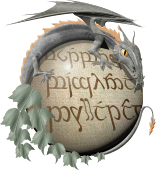- Cities and buildings
- Fields, plains and deserts
- Forests
- Hills and mountains
- Islands and promontories
- Lands, realms and regions
- Rivers and lakes
- Seas and oceans


 |
||||||||||
|


Which personality type are you?
Take the Free mydiscprofile Personality Test to discover your core personality and your ideal job.   Which personality type are you? |
|
Dates
Origins
Races
Originated with the Elves, but widely used by other peoples
Pronunciation
te'lko
Meaning
'Stem'1
|
TelcoA stroke in Elven writingThe Tengwar of Fëanor represented a sophisticated system of writing. The primary characters of the script were not arbitrary, but were designed so that the structure of each letter represented the sound associated with it. These phonetic symbols, divided into témar or sound-series, each consisted of a standardised basic structure, with a curved arc, the lúva, extending out from a straight stem. This straight stem or line was the telco, and its position within the character, as well as its orientation relative to the lúva, defined the sound represented by the letter. A complication of the Fëanorian system was that the sound structure was not fixed, and so the values of the characters could vary depending on the scheme in use. Based on the typical system, the tengwar with the telco drawn down the left-hand side belonged to the tincotéma or parmatéma (variations on the sounds 't' and 'p'). The use of the telco to the right was more complex, as the series involved tended to vary according to the language being represented, but they typically included the calmatéma or quessetéma (variations on the sounds 'k' or 'kw'). For 'stops' or distinct consonantal sounds, the telco was written to extend upward from the form of the letter. So, for sounds like b, d, p or t, the stem would run upward from the tengwa. A telco written with a downward, conversely, represented a spirant, a variant sound made with a continuous flow of breath. Examples of these spirants would be sounds like f, th or dh. Any of these sounds could be voiced or unvoiced2 (the distinction of voice being made by the lúva, which was doubled for voiced sounds). It was theoretically possible to write a tengwa with a 'double' telco, extending upward and downward in the same character. This represented an aspirated consonant,3 but such sounds were almost unknown in the main languages written with the tengwar, and so this double telco was very rarely used in practice. Finally, there were letters with a short, unextended telco, a simple line that did not extend above or below the bowed lúva shape. These tended to be used less formally than the others, to represent common sounds that did not necessarily belong to the same téma or sound-series as the others of their kind. Characters with a double lúva and a short telco commonly represented nasal sounds such as m or n. Finally, a single lúva and a short telco represented a 'weak' sound (such as an untrilled r sound4 or a w sound). Notes
For acknowledgements and references, see the Disclaimer & Bibliography page. Original content © copyright Mark Fisher 2000, 2015, 2023. All rights reserved. For conditions of reuse, see the Site FAQ. Website services kindly sponsored by myDISCprofile, the free online personality test.Explore the benefits of using a personality profile to discover yourself and make the most of your career. |